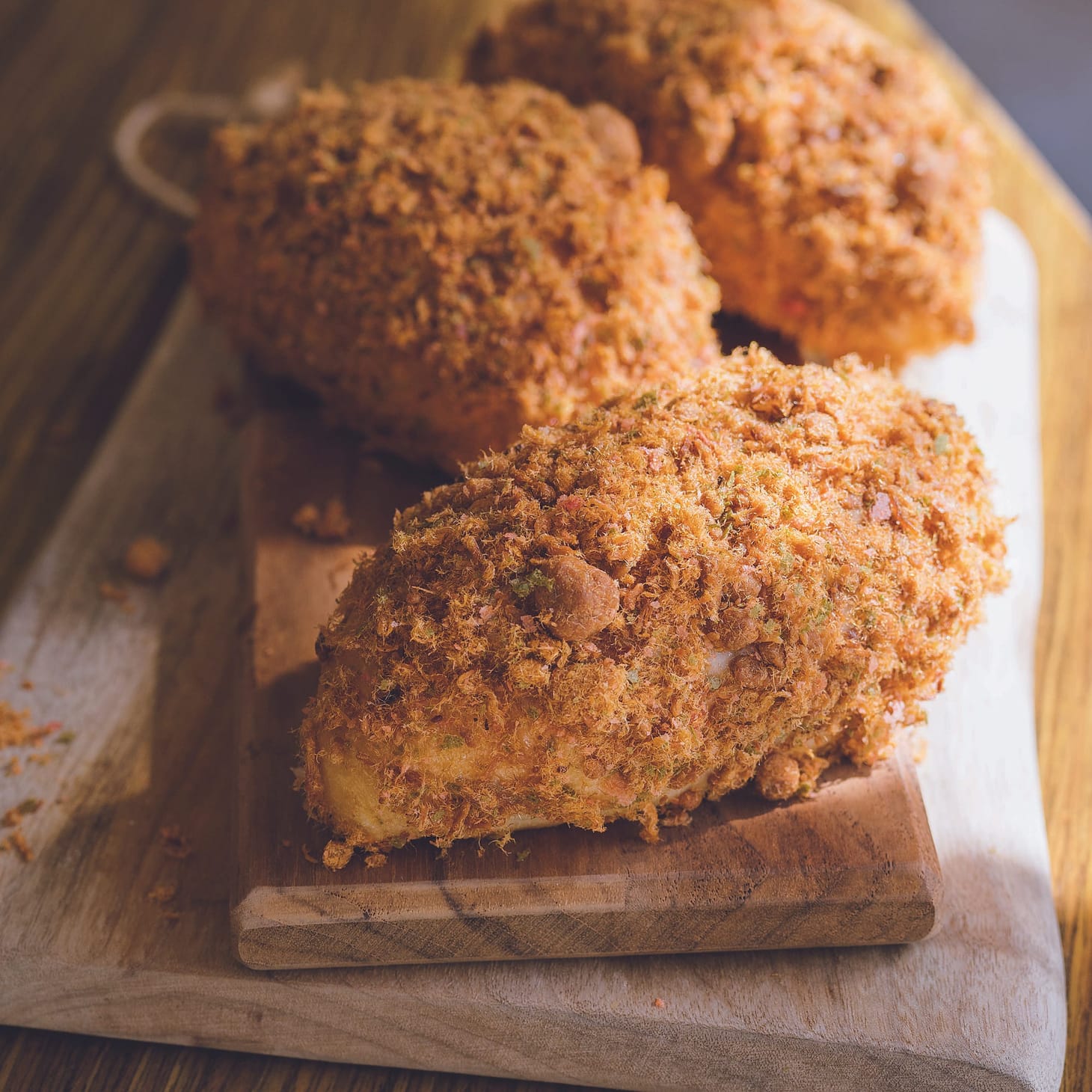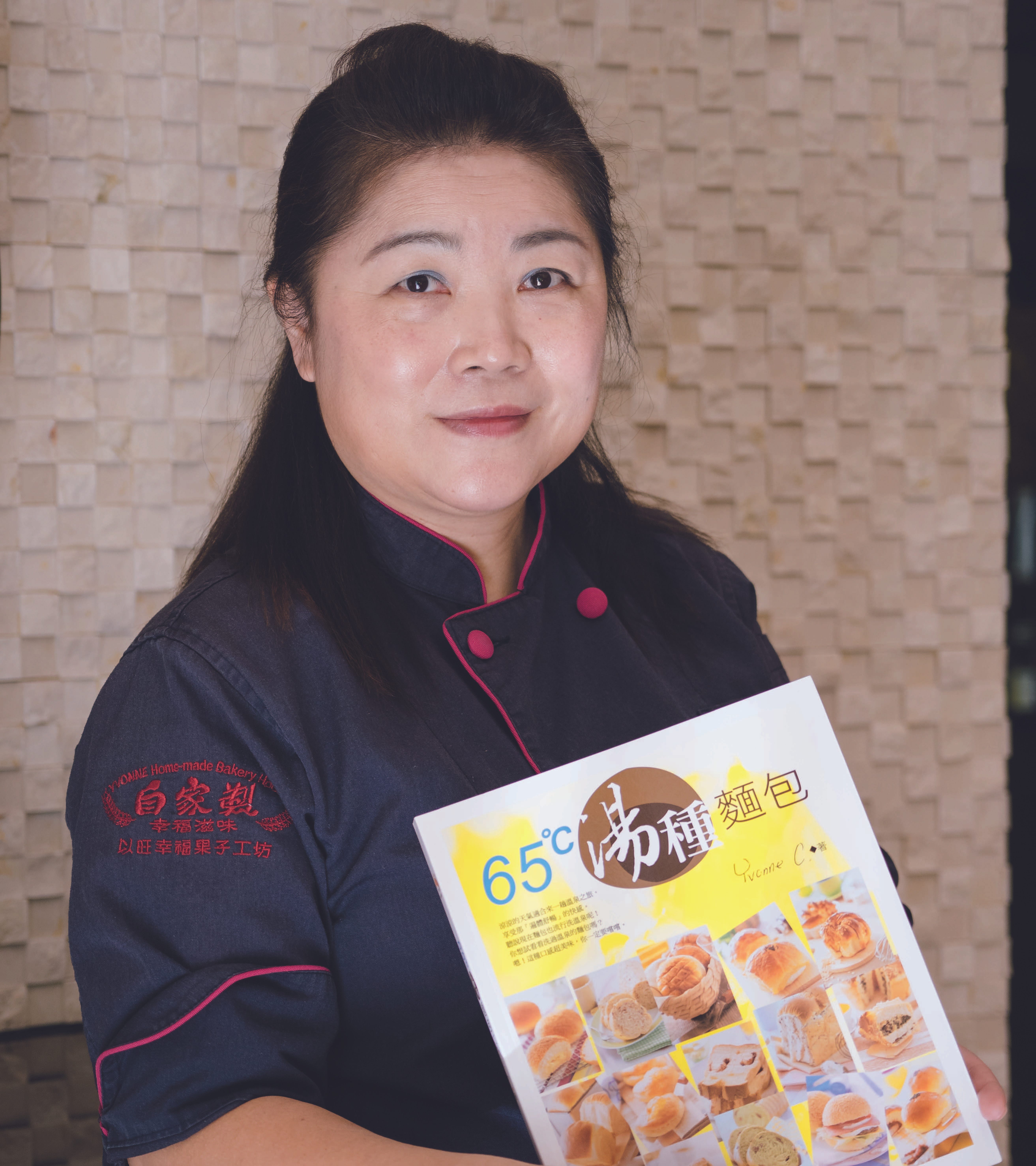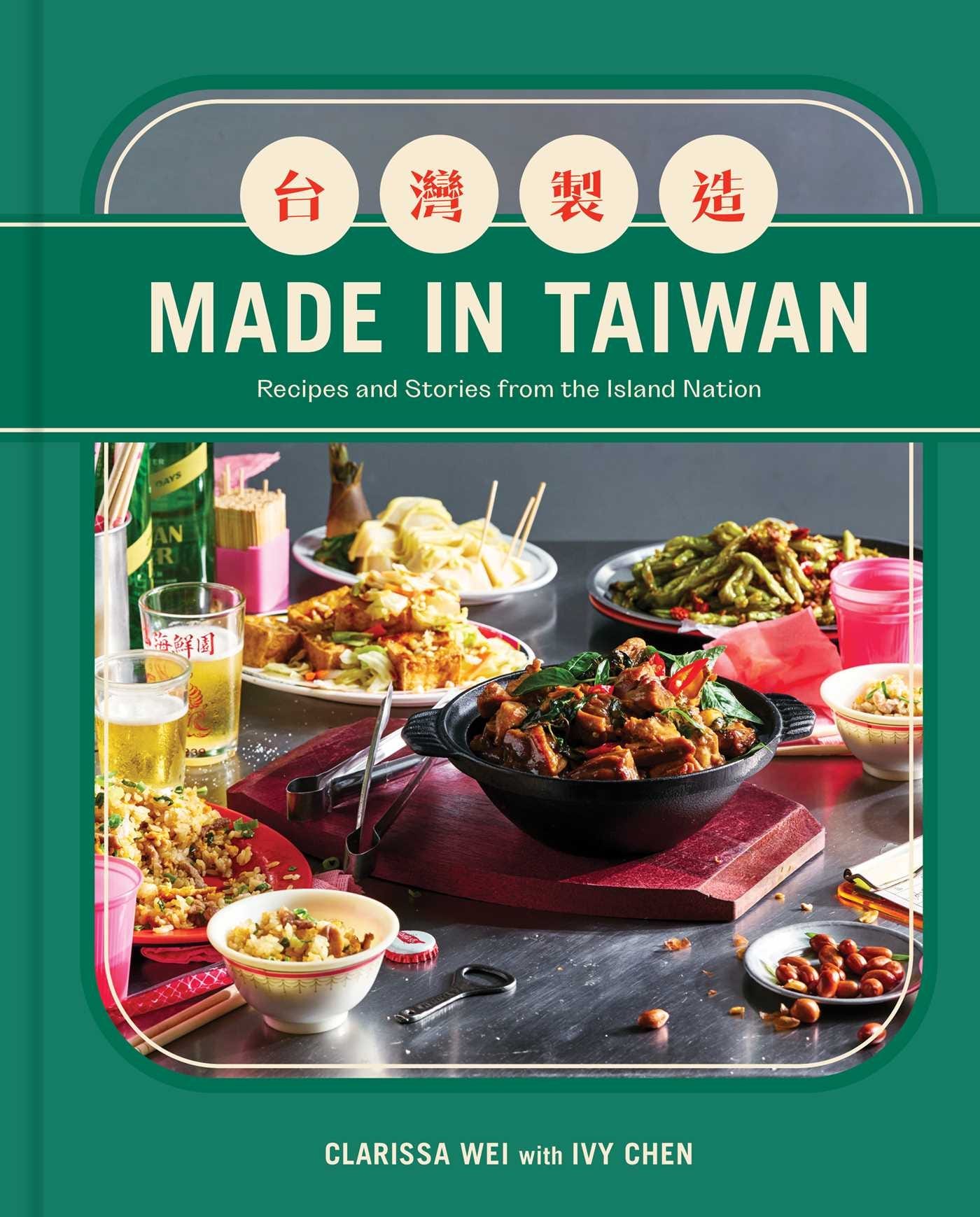Recipe: Pork Floss Milk Bread
From Clarissa Wei's 'Made in Taiwan'

Table of Contents
At the coffee shop where I meet her, Taiwanese pastry chef and teacher Yvonne Chen 陳郁芬 orders a plain piece of buttered toast with strawberry jam and rips it apart the moment it arrives at the table. It’s an accordion of light, feathery wisps of dough. She inspects the bread closely, takes a deep whiff, and nods in mild approval as she dips chunks of it into the glistening jam.

Baking blogs around the world often credit Yvonne with inventing tāngzhoˇng 湯種, the creamy gelatinized substance in Asian breads made by whisking together scalding water and flour at a 1:5 ratio and heating it up to 150°F (65°C) to form a thick slurry. When combined with the rest of the ingredients, the slurry basically gelatinizes part of the dough, which helps the final bread retain moisture. It’s what gives Asian breads their signature cloudlike texture, though Yvonne stresses that the credit is misdirected and she didn’t actually invent tangzhong at all. A similar technique has been used all over East Asia for generations, and it was the Japanese who first coined and codified this particular procedure for bread. Yvonne picked it up during culinary school in Taiwan, and her name became synonymous with it only when she wrote a popular cookbook in 2007 called 65 Degrees C, a nod to the temperature at which tangzhong is made. “It’s normally used just for toast, but I apply it to everything,” she tells me.
Pork Floss Milk Bread (肉鬆麵包 ròu sōng Miàn Bāo / 肉酥麭 Bah soo Pháng)

Pork Floss Milk Bread Recipe390KB ∙ PDF fileDownloadDownload
MAKES 6 buns
SPECIAL EQUIPMENT:
stand mixer with dough hook attachment (optional)
NOTE:
- If you don’t have access to Kewpie mayonnaise, mix 1/2 cup regular mayonnaise with 1 1/2 tablespoons white sugar for a quick version.
- Yvonne’s original recipe uses milk powder and water, but I’ve substituted whole milk here instead.
FOR THE TANGZHONG:
1 1/2 tablespoons (12 g) bread flour
1/4 cup (60 ml) whole milk
FOR THE BREAD:
1/2 cup plus 2 tablespoons (90 ml) whole milk
1 teaspoon active dry yeast
2 cups (250 g) bread flour
1 large egg (50 ml)
2 tablespoons white sugar
1/4 teaspoon fine sea salt
1 1/2 tablespoons (20 g) unsalted butter, softened and cut into 1⁄2-inch (1-cm) pieces
canola or soybean oil
FOR THE EGG WASH:
1 large egg
1 tablespoon whole milk
FOR THE TOPPINGS:
1/2 cup (115 g) kewpie mayonnaise (see Note)
1 1/4 cup (80 g) pork floss (store-bought or homemade; see below)
- MAKE THE TANGZHONG: In a small saucepan, combine the bread flour and milk, and stir until the flour is completely dissolved. Bring to a simmer over low heat and cook, stirring constantly, until the mixture is glue-like, about 3 minutes. Immediately remove from the heat, transfer to a container, and let it cool to room temperature. Refrigerate for a minimum of 2 hours or overnight (“It must be cold,” advises Yvonne).
- MAKE THE BREAD: In a small saucepan set over low heat, heat the milk until tiny bubbles begin to break on the surface and it starts to steam. Turn off the heat and wait until the milk is cool but still lukewarm and comfortable to the touch, about 105°F (40°C). Sprinkle the active dry yeast over the milk, stir to dissolve, and let it sit until frothy, about 5 minutes.
- In a large bowl or the bowl of a stand mixer, combine the bread flour, egg, sugar, salt, the refrigerated tangzhong, and the yeast-milk mixture. Mix until it forms a shaggy dough. Add the butter one piece at a time and knead the dough with your hands until it forms a solid dough, about 5 minutes. (Alternatively, churn in a stand mixer with the dough hook attachment on low speed until it forms a smooth ball, about 3 minutes.) The dough should be soft and quite sticky.
- Lightly grease the inside of a bowl with oil. Lift the dough out of the mixing bowl, shape it into a ball and place it in the oiled bowl. Cover it with plastic wrap and let it rest until it has doubled in size, 1 to 2 hours at room temperature or overnight in the refrigerator.
- Punch the air out of the dough and scoop it out onto a lightly oiled surface. Using a bench scraper, divide the dough into 6 even pieces, about 78 g each. Gently knead each piece until it forms a very smooth ball. Cover the balls with plastic wrap and let rest at room temperature for 10 minutes.
- With a rolling pin, flatten a dough ball into an oval, about 6 inches (15 cm) long. Starting from the top tip of the oval, tightly roll up the dough toward you into
a log. Pinch the sides and seams together and fluff it up gently (“It should look like an olive,” says Yvonne). Repeat with the rest of the dough balls. Place the logs on a baking sheet seam side down, leaving a couple of fingers’ worth of space between each of them. Don’t worry if the tops aren’t completely smooth; they’ll smooth themselves out when baked. Cover and let rest at room temperature until they have puffed up and are soft to the touch, 30 to 40 minutes. If you poke them gently, they should spring back up again slowly. - Preheat the oven to 350°F (175°C).
- APPLY THE EGG WASH: In a small bowl, whisk together the egg and milk. Brush the egg wash on the tops and sides of the buns with a pastry brush.
- Bake the buns until the tops are golden brown, about 15 minutes. Take the buns out of the pan and place them on a wire rack to cool down completely to room temperature.
- FOR THE TOPPINGS: With a sharp knife, make a vertical incision into the buns (like it’s a hot dog bun), but don’t cut all the way through and don’t cut to the edge. Spread some Kewpie mayonnaise inside, then cover up the incision by spreading more mayonnaise on top. Layer an even mat of pork floss on top of the mayonnaise. Repeat with the remaining buns. To store, put the buns in an airtight container and store at room temperature. The bread should be eaten within 2 days.
Pork Floss (豬肉鬆 Zhū Ròu Sōng/ 豬肉酥 Ti Bah Soo)

Pork Floss263KB ∙ PDF fileDownloadDownload
MAKES 2 CUPS (170 G)
Before the advent of refrigeration, making pork floss was just a way to elongate the shelf life of meat. It's dehydrated pork flavored with soy sauce, sugar, and five-spice powder, shredded so finely that it's reminiscent of a clump of hair. These days, pork floss can be purchased at most Asian specialty stores, which is what I recommend doing, because making it at home can be quite time-consuming. However, the steps are well worth it if you have a craving and don't have access to a store that sells it, or just want to take on a fun challenge.
1 pound (450 g) pork tenderloin
1 tablespoon Taiwanese rice
1 scallion, tied in a knot
wine (michiu) or cooking sake
1 ½-inch piece fresh ginger
½ teaspoon fine sea salt (5 g), unpeeled and sliced
⅛ teaspoon ground white pepper
2 tablespoons white sugar
⅛ teaspoon five-spice powder
1 tablespoon soy sauce
⅛ teaspoon ground cinnamon
2 teaspoons lard or sesame oil
- Slice the pork along the grain into long strips, about 1 inch (2.5 cm) thick. Cut the strips crosswise against the grain so that each strip measures about 2 inches (5 cm) long.
- In a small pot set over high heat, add the sliced pork tenderloin and enough water to cover. Bring to a boil, then reduce the heat to medium and briskly simmer for 5 minutes. Turn off the heat. Drain in a colander set in the sink and rinse quickly under running water to get rid of the excess scum.
- In a small pot, bring 1¼ cups (300 ml) water to a rolling boil. Add the pork tenderloin, scallion, ginger, sugar, soy sauce, rice wine, salt, white pepper, five-spice powder, and cinnamon and bring everything to a boil. The liquid should just barely cover the pork. Cover, reduce the heat to low, and slowly simmer with the lid slightly ajar until the pork is soft and the liquid reduces to half, 1½ to 2 hours. As the liquid starts to reduce, rotate the pork pieces occasionally with chopsticks. Turn off the heat.
- Preheat the oven to 225°F (110°C).
- When the pork is cool enough to handle but still warm, remove it from the pot and shred it with your hands or a fork. Reserve the braising liquid. When all the pork has been shredded, transfer it to the bowl of a stand mixer, pour in the braising liquid, and mix with the paddle attachment on medium speed until the liquid is mostly absorbed and the pork breaks apart completely and looks like pulled pork, about 2 minutes.
- Transfer the mixture to a parchment paper-lined sheet pan and spread it out in a single even layer. Bake for 15 minutes, until the pork is slightly dried out. Transfer to the stand mixer and mix again with the paddle attachment on medium speed until the pieces break up even more finely, about 2 minutes. Repeat this process 4 to 5 more times, baking in 15-minute increments and then mixing with the paddle attachment for 2 minutes until the pork is completely dried out and fluffy with the texture of clumped-up floss. The final color will be reminiscent of cardboard. The total baking time will range between 14 and 1½ hours. After the final bake, remove the sheet pan from the oven and, while the pork floss is still hot, mix in the lard. Cool the pork floss down completely to room temperature before use. To store, transfer to an airtight jar. Pork floss can be stored at room temperature for 1 month or in the refrigerator for 3 months.

Excerpted from MADE IN TAIWAN: Recipes and Stories from the Island Nation. Copyright @ 2023 by Clarissa Wei. Photography Copyright © 2023 by Yen Wei and Ryan Chen. Reproduced by permission of Simon Element, and imprint of Simon & Schuster. All rights reserved.
wordloaf Newsletter
Join the newsletter to receive the latest updates in your inbox.




